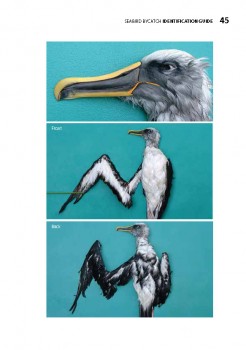The ACAP Seabird Bycatch Identification Guide is primarily intended for use at sea by fisheries observers to assist in the identification of albatrosses and some commonly caught petrels and shearwaters brought aboard after being killed in longline operations. Where possible, species identification is based on those characteristics that are most likely to be preserved in dead birds that may have been underwater for long periods of time. In most cases, these are primarily bill size and colour. Because dead birds may look quite different to live birds, where possible, the photos included in the ID guide are of dead birds. In some cases it will not be possible to identify a bird to a single species, but it should be possible in most cases to narrow the identification down to two or three possibilities. For species with a restricted range, distribution maps have been added to eliminate them from the possible options.

The guide covers 37 procellariiform species, including 30 of the 31 listed within the Agreement. The ACAP-listed Balearic Shearwater Puffinus mauretanicus is not currently covered. French, Spanish (both ACAP official languages) and Mandarin versions will be available next month, and Japanese, Korean, Portuguese and Chinese Taipei versions are expected to become available in October. The ACAP Secretariat can be contacted for commercial print-quality files, in any of these languages, to print for users’ local needs.


Text, map and identification photographs for Buller's Albatross Thalassarche bulleri from the guide
The Seabird Bycatch Identification Guide has been printed on glossy water-resistant card with a ring binding that allows it to lie flat, although individual users are encouraged to print and use it in the format that best suits their needs. It has been produced and published (under a Creative Commons license) in collaboration with Japan’s National Research Institute of Far Seas Fisheries. It is planned to produce an interactive, electronic version that could be used on mobile devices.
The principal authors of the guide are Nadeena Beck, Yukiko Inoue and Hiroshi Minami. ACAP gratefully acknowledges Richard Phillips, Ross Wanless and Karen Baird for their helpful suggestions on the original draft and also thanks Hiroshi Hasegawa, Hadoram Shirihai, James Lloyd, Aleks Terauds, Ron LeValley, Barry Baker, Ross Wanless, Andrea Angel, Roger Kirkwood, Scott Shaffer, John Cooper, Tony Palliser, Graham Robertson, Brook Whylie, Tui de Roy, David Thompson, Drew Lee, Flavio Quintana, Marienne de Villiers, Ben Phalan, the Department of Conservation, New Zealand, Mike Double and Peter Hodum for their photographs.
Reference:
ACAP Secretariat & National Research Institute of Far Seas Fisheries 2015. Seabird Bycatch Identification Guide, updated August 2015. Hobart: ACAP Secretariat. 100 pp.
John Cooper, ACAP Information Officer, 27 August 2015

 English
English  Français
Français  Español
Español